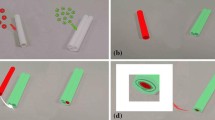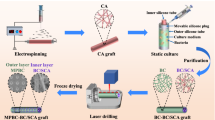Abstract
In this study, natural lecithin was incorporated into cholesterol-poly(ε-caprolactone) (Chol-PCL) by solution blending in order to modify the performance of the hydrophobic and bio-inert PCL. The fibrous Chol-PCL/lecithin membranes were fabricated by electrospinning, and the surface morphology and properties were characterized by scanning electron microscopy, X-ray photoelectron spectroscopy, static water contact angle, and mechanical tensile testing. The blood compatibility of the scaffolds was evaluated by in vitro hemolysis assay. The cytocompatibility of the scaffolds was investigated by cell adhesion and proliferation using bone-marrow mesenchymal stem cells (MSCs). Subcutaneous implantation was also performed to evaluate the in vivo inflammatory reaction. The tubular tissue-engineered vascular graft (TEVG) was further constructed by rolling cell sheet comprising fibrous membrane and MSCs. Furthermore, endothelial cells (ECs) were seeded onto the lumen of the graft with the aim to form vascular endothelium. The preliminary results indicate that electrospun Chol-PCL/lecithin scaffolds show improved hemocompatibility and cytocompatibility compared with neat Chol-PCL, and combining the Chol-PCL/lecithin fibrous scaffold with MSCs and ECs with well controlled distribution is a promising strategy for constructing TEVGs.










Similar content being viewed by others
References
Stitzel J, Liu J, Lee SJ, Komura M, Berry J, Soker S, Lim G, van Dyke M, Czerw R, Yoo JJ, Atala A. Controlled fabrication of a biological vascular substitute. Biomaterials. 2006;27:1088–94.
Baguneid MS, Seifalian AM, Salacinski HJ, Murray D, Hamilton G, Walker MG. Tissue engineering of blood vessels. Br J Surg. 2006;93:282–90.
Greiner A, Wendorff JH. Electrospinning: a fascinating method for the preparation of ultrathin fibers. Angew Chem Int Ed. 2007;46:5670–703.
Woodruff MA, Hutmacher DW. The return of a forgotten polymer-polycaprolactone in the 21st century. Prog Polym Sci. 2010;35:1217–57.
Lee SJ, Yoo JJ, Lim GJ, Atala A, Stitzel J. In vitro evaluation of electrospun nanofiber scaffolds for vascular graft application. J Biomed Mater Res. 2007;83A:999–1008.
Pektok E, Nottelet B, Tille JC, Gurny R, Kalangos A, Moeller M, Walpoth BH. Degradation and healing characteristics of small-diameter poly(ε-caprolactone) vascular grafts in the rat systemic arterial circulation. Circulation. 2008;118:2563–70.
Mathews S, Kaladhar K, Sharma CP. Cell mimetic monolayer supported chitosan-haemocompatibility studies. J Biomed Mater Res. 2006;79A:147–52.
Nakaya T, Li YJ. Phospholipid polymers. Prog Polym Sci. 1999;24:143–81.
Shi X, Wang Y, Ren L, Huang W, Wang DA. A protein/antibiotic releasing poly(lactic-co-glycolic acid)/lecithin scaffold for bone repair applications. Int J Pharm. 2009;373:85–92.
McKee MG, Layman JM, Cashion MP, Long TE. Phospholipid nonwoven electrospun membranes. Science. 2006;311:353–5.
Park SA, Park KE, Kim W. Preparation of sodium alginate/poly(ethylene oxide) blend nanofibers with lecithin. Macromol Res. 2010;18:891–6.
Zhu N, Cui FZ, Hu K, Zhu L. Biomedical modification of poly(L-lactide) by blending with lecithin. J Biomed Mater Res. 2007;82A:455–61.
Wang Y, Cui FZ, Jiao YP, Hu K, Fan DD. Modification of bone graft by blending with lecithin to improve hydrophilicity and biocompatibility. Biomed Mater. 2008;3:15012.
Xu ZH, Wu QY. Effect of lecithin content blend with poly (L-lactic acid) on viability and proliferation of mesenchymal stem cells. Mater Sci Eng, C. 2009;29:1593–8.
Shi X, Wang Y, Ren L, Lai C, Gong Y, Wang DA. A novel hydrophilic poly(lactide-co-glycolide)/lecithin hybrid microspheres sintered scaffold for bone repair. J Biomed Mater Res. 2010;82A:963–72.
Shen J, Fu X, Ou L, Zhang M, Guan Y, Wang K, Che Y, Kong D, Steinhof G, Li W, Yu Y, Ma N. Construction of ureteral grafts by seeding urothelial cells and bone marrow mesenchymal stem cells into polycaprolactone-lecithin electrospun fibers. Int J Artif Organs. 2010;33:161–70.
Motlagh D, Allen J, Hoshi R, Yang J, Lui K, Ameer G. Hemocompatibility evaluation of poly(diol citrate) in vitro for vascular tissue engineering. J Biomed Mater Res. 2007;82A:907–16.
Weinberg CB, Bell E. A blood vessel model constructed from collagen and cultured vascular cells. Science. 1986;231:397–400.
Nerurkar NL, Sen S, Baker BM, Elliott DM, Mauck RL. Dynamic culture enhances stem cell infiltration and modulates extracellular matrix production on aligned electrospun nanofibers scaffolds. Acta Biomater. 2011;7:485–91.
L’Heureux N, Dusserre N, Konig G, Victor B, Keire P, Wight TN, Chronos NAF, Kyles AE, Gregory CR, Hoyt G, Robbins RC, McAllister TN. Human tissue-engineered blood vessels for adult arterial revascularization. Nat Med. 2006;12:361–5.
Sales KM, Salacinski HJ, Alobaid N, Mikhail M, Balakrishnan V, Seifalian AM. Advancing vascular tissue engineering: the role of stem cell technology. Trends Biotechnol. 2005;23:461–7.
Hashi CK, Zhu Y, Yang GY, Young WL, Hsiao BS, Wang K, Chu B, Li S. Antithrombogenic property of bone marrow mesenchymal stem cells in nanofibrous vascular grafts. Proc Natl Acad Sci. 2007;104:11915–20.
Gong Z, Niklason LE. Small-diameter human vessel wall engineered from bone marrow-derived mesenchymal stem cells (hMSCs). FASEB J. 2008;22:1635–48.
Roh JD, Sawh-Martinez R, Brennan MP, Jay SM, Devine L, Rao DA, Yi T, Mirensky TL, Nalbandian A, Udelsman B, Hibino N, Shinoka T, Saltzman WM, Snyder E, Kyriakides TR, Pober JS, Breuer CK. Tissue-engineered vascular grafts transform into mature blood vessels via an inflammation-mediated process of vascular remodeling. Proc Natl Acad Sci. 2010;107:4669–74.
Cines DB, Pollak ES, Buck CA, Loscalzo J, Zimmerman GA, McEver RP, Pober JS, Wick TM, Konkle BA, Schwartz BS, Barnathan ES, McCrae KR, Hug BA, Schmidt AM, Stern DM. Endothelial cells in physiology and in the pathophysiology of vascular disorders. Blood. 1998;91:3527–61.
Sarkar S, Sales KM, Hamiton G, Seifalian AM. Addressing thrombogenicity in vascular graft construction. J Biomed Mater Res. 2007;82B:100–8.
Hu X, Liu G, Ji J, Fan D, Yan X. Lipid-like diblock copolymer as an additive for improving the blood compatibility of poly(lactide-co-glycolide). J Bioact Compat Polym. 2010;25:654–68.
Hong Y, Ye SH, Nieponice A, Soletti L, Vorp DA, Wagner WR. A small diameter, fibrous vascular conduit generated from a poly(ester urethane)urea and phospholipid polymer blend. Biomaterials. 2009;30:2457–67.
Ishihara K, Oshida H, Endo Y, Ueda T, Watanabe A, Nakabayashi N. Hemocompatibility of human whole blood on polymers with a phospholipid polar group and its mechanism. J Biomed Mater Res. 1992;26:1543–52.
Iwasaki Y, Tojo Y, Kurosaki T, Nakabayashi N. Reduced adhesion of blood cells to biodegradable polymers by introducing phosphorylcholine moieties. J Biomed Mater Res. 2003;65A:164–9.
Acknowledgments
The work was financially supported by NSFC (Nos. 50830104 and 81000680), Research Fund for the Doctoral Program of Higher Education of China (No. 20100031120021), and Science & Technology Project of Tianjin of China (No. 12JCQNJC09300).
Author information
Authors and Affiliations
Corresponding authors
Additional information
Min Zhang and Kai Wang contributed equally to this study.
Electronic supplementary material
Below is the link to the electronic supplementary material.
Rights and permissions
About this article
Cite this article
Zhang, M., Wang, K., Wang, Z. et al. Small-diameter tissue engineered vascular graft made of electrospun PCL/lecithin blend. J Mater Sci: Mater Med 23, 2639–2648 (2012). https://doi.org/10.1007/s10856-012-4721-4
Received:
Accepted:
Published:
Issue Date:
DOI: https://doi.org/10.1007/s10856-012-4721-4




